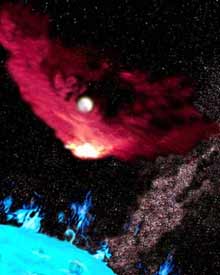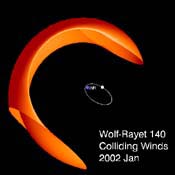
This artist's conception shows a brilliant red arc where winds from a blue-hot, supermassive Wolf-Rayet star and its O-type companion collide.
Courtesy David Aguilar (Harvard-Smithsonian Center for Astrophysics).
The latest steps in an 8-year-long stellar tango have been tracked by one of the world's largest telescopes, astronomers reported yesterday at the American Astronomical Society meeting in Washington, D.C.
Wolf-Rayet (WR) stars are ultra-hot stellar heavyweights in their final presupernova stage of life. They tip the scales at some 25 solar masses (or more) and shine so brightly that their outermost atmospheres fly off into surrounding space. But WR140 is superlative even among Wolf-Rayets. It's a binary system in which an O-type star orbits an even larger Wolf-Rayet companion. Given such energetic dance partners, the last thing astronomers would expect to see in the system is dust — any grains in the environs should be blasted apart in the strong radiation field.
But astronomers do see dust around WR140, and they see it in a spectacular fashion. During the O-type star's 8-year-long orbit, it approaches within 2.5 astronomical units (375 million kilometers) of the WR star. At this close approach, called periastron, the two star's energetic winds smash into each other, creating a shock front that, oddly enough, provides a dense, shielded environment where dust grains can form.

Click on this image to see an animation (266K GIF) showing how the energetic Wolf-Rayet binary star system WR140 spews out an arc of dust when the smaller star passes 2.5 astronomical units from its companion.
Courtesy John Monnier (Harvard-Smithsonian Center for Astrophysics).
John Monnier (Harvard-Smithsonian Center for Astrophysics), Peter Tuthill (University of Sydney, Australia) and William Danchi (NASA/Goddard Space Flight Center) have been monitoring the WR140 system for the past few years using the Keck I telescope. Their technique is of particular note — with special optics they essentially cover the 10-meter primary mirror with an aperture mask containing 36 small holes. By mixing the signals from each of these microtelescopes, they turn Keck's mirror into a "multi-element interferometer." In doing so, Monnier and his colleagues attain an incredible imaging resolution of some 20 milliarcseconds — 50 times better than typical obtained from ground-based instruments.
By watching the system before and after its February 2001 periastron event, Monnier and his team found that "a bow shock arc of dust is seen within one month of periastron," says Monnier. Danchi adds that the system spews dust, "like a nozzle shooting material from a sprinkler." The result is an enormous spiral of gas cast out into space. Monnier's team is the first to ever see such a transient dust shield and to track its very high-speed motion (up to one milliarcsecond per day).
 0
0
Comments
You must be logged in to post a comment.